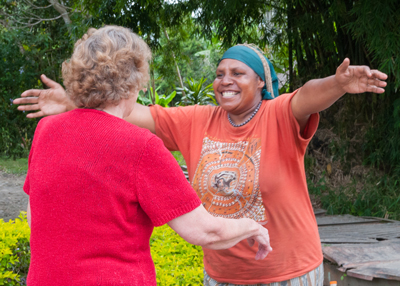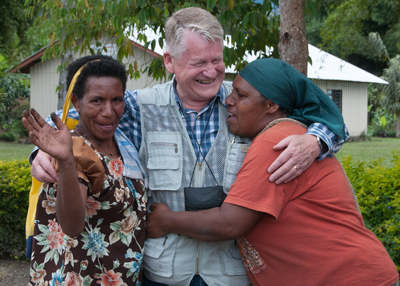1. Papua New Guinea April 2012 |
”Sven, Spen, Seven, Span!” The pronunciation varies but one cannot ignore the joy of the people who cried out Sven's and Marianne's names when we in the beginning of April 2012 were visiting various places in and around Mount Hagen in the highlands of Papua New Guinea. For Rode, my wife, and I, Leif Kennerberg, it is an old dream coming true to, alongside with Sven and Marianne Göransson, or Goransson as they have been named for a long time in Australia, visit the Papua New Guinea where the couple were missionaries between 1976 and 1995. Sven and Marianne saw many people coming to believe in Jesus during their stay there. There was a church consisting of approximately 50 members when they first reached the Highlands. Today, this establishment has grown to consist of 400 churches with about 60,000 members. But those who came to believe were not the only ones involved – the whole community was affected by what was happening. In 1976, tribal wars and blood feuds were still common occurrences in the Highlands, but today these events have – thankfully – almost vanished. 
Marianne is welcomed in Papua New Guinea in April 2012 Up until 1933, people in the Highlands of Papua New Guinea led very isolated lives. This was the year when the first white man came to the Highlands and found a people who lived according to the Stone Age standards. They hunted with stone axes, bows and arrows. Cannibalism and polygamy as well as tribal battles and blood feuds were frequently seen in this society (these blood feuds were a retaliation which relatives of a slain person arbitrarily exercised by killing the offender or members of his family). When Kundi Pok from Papua New Guinea, together with Sven and Marianne came to visit us in Sweden in 1979, he showed great appreciation for things that we took for granted. As an example, he thought it was very strange that you could step into a small room – an elevator – and then step out to find yourself in a whole new area. Kundi Pok showed the same admiration when seeing our windows equipped with blinds. Where did the blinds go? When his son Yuticas Pok 31 years later visits us it is a man who comes with mobile phone and the latest model of laptop. It illustrates quite well the tremendous leap that this people have taken in a historically short period of time. |
There are still people living in the Highlands in Papua New Guinea who were born into a society where they were dependent on stone, bamboo and bones to make tools and where metal or glass objects were never to be seen. Although, now when they have reached an older age, they see children and grandchildren running around with smart phones and laptops. The same development that took hundreds of years in Sweden was carried out in less than a generation in the Highlands of Papua New Guinea. Today, it does not seem to be any undiscovered villages left, but as late as 1995, when Sven and Marianne ended their active missionary work in Papua New Guinea, one had just recently discovered a village that had not been in any contact with the outside world before. 
Sven in happy reunion in Papua New Guinea in April 2012 During one of our many conversations, I asked Sven if he had thought about writing about his experiences as a missionary. I was not the first one to ask him this question, he answered, but he considered this task to be hard. I then wondered if he would like to tell me his story – Sven liked that idea. Said and done, back in Brisbane, Australia, I bought a small digital tape recorder and during a 15 days´ tour in Australia, we spent the evenings interviewing the Goranssons. What you will read about in the following chapters is the result of Sven's and Marianne's stories. I am neither a writer nor a journalist myself, and it has not been an easy task sorting out the material, which has not always been recorded in a logical order. But with a little hard work, I personally feel that I managed to create an interesting story, although you as a reader must make up your own mind about this. Thanks to my loved ones, I have also managed to get some order in the language aspects and sentence structure. I hope you will enjoy taking part of a story about two people living on opposite sides of the globe, who, by being responsive to the call of God, got to witness how a society was transformed by the Gospel of salvation. In the short time that was available for us to converse, it was obviously difficult to cover everything that Sven and Marianne experienced during their many years as missionaries, although I hope and believe that the very essence is still captured and conveyed in the following chapters. I have written some parts of the book from my own perspective and other parts are written from Sven´s and Marianne´s perspective. The pictures illustrating this story are mostly photographs from Sven's and Marianne's own photo album. Some of them are my own photographs and a few are borrowed from Bengt Jägerskog. The owner of the rights of each photo appears when you hover with your computer arrow over the different images. Between 2009 and 2010, Bengt Jägerskog created the amazing film “Mission Papua". It has been shown several times on the “Swedish Television” (Sveriges Televison) and the film portrays Sven's and Marianne's missionary work in Papua New Guinea. The initiator of the film was Krister Sköld.
|